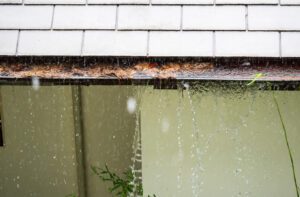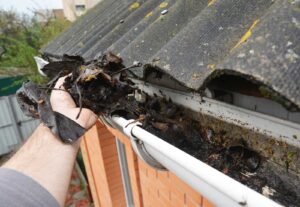What Does a Gutter Guard Installation Cost in 2023?
The gutters on your home are designed to channel efficiently from the roof to the ground. When gutters fill with leaves, they can no longer drain water, potentially causing many issues for your home.
For heavily forested areas or other areas prone to a lot of debris, it may be inconvenient to have gutters cleaned on a regular basis, which is where leaf gutter guards come in.
How do you know if these leaf guards are a good fit for your property, and how much does gutter guard installation cost? Find the answers below.
Do Gutter Guards Work?
The short and direct answer is yes, gutter guards work. However, it’s crucial to entrust their installation to a professional. Seek out an installer with expertise who can select a product tailored to your home and property location, ensuring it doesn’t compromise your roof’s warranty.
While some homeowners may consider DIY solutions, some of which can be as inexpensive as $1 per foot, it’s essential to understand that with gutter guards, you genuinely get what you pay for. These budget systems typically have a short lifespan and aren’t recommended by reputable contractors.
What is the Average Cost of Gutter Guards in 2023?
The average cost of gutter guards can range between $700 and $3,000 for a professional gutter guard installation.
Gutter guard installation costs are going to vary between homes. Numerous factors figure into the costs of installing gutter guards, and it’s nearly impossible to give an estimate site unseen. That’s why you should make sure any professional you contact gives a free estimate on your gutter guard installation.
And, because there are so many different things involved, it’s important to consult with professionals.
Factors Impacting Gutter Guard Installation Cost
Gutter guard installation can be expensive and typically, this isn’t because of one single reason. Here are the three biggest factors that come into play with estimating the costs of gutter guard installation:
Labor & Simple vs Complex Jobs
Factors like multi-level structures, complex gutter systems that are challenging to reach, and other variables affecting both the timeframe and the required workforce can influence the estimate.
Some States & Cities are More Expensive
Cities with less greenery tend to cost less than ones that are heavily wooded. For example, professionally installed gutter guards in Miami, Florida could be less expensive than guards installed in Charlotte, NC. What’s the big difference? Miami’s doesn’t have an autumn season with heavy falling leaves, whereas the Charlotte Metro area has over 100,000 acres of tree canopy.
The Size of the Gutter Guard System Project
The average home has between 100-200 feet of gutters. Assuming that replacing part or all of your gutter system isn’t necessary, homeowners can multiply their gutter by the price per foot of a product. We’ll go over the products below and which ones are best for your needs.
Selecting the Right Gutter Leaf Guard System
Cost Per Foot and Overall Cost
Selecting the best gutter guard system is important. The best system for you will depend on your roof, the type of gutters you have, and the area you’re in. Here is a quick review of some of the most popular types and the cost of each.
| Gutter Guard Price & Type Comparison | ||
| Type | $/linear foot | Overall Cost |
| Foam Leaf Guards | $.50 to $1.50 | $400 to $1,300 |
| Aluminum Guard | $1.00 – $1.75 | $600 – $1,700 |
| Metal Mesh Screens | $1.50 to $3.50 | $800 to $2,500 |
| Micro Mesh Screens | $3.50 – $6.50 | 2,000 to $7,000 |
| Reverse Gutter Guards | $3.50 to $6.50 | 2,000 to $7,000 |
Keep reading to learn more about these three types of leaf guards.
Pros and Cons of Different Gutter Guard Systems
Metal Leaf Guards

Mesh leaf guards have a frame and steel mesh that allows for water to pass into your gutters, but not larger debris, like leaves. Many homeowners like these because they are low profile and won’t distract from a home’s appearance. Metal mesh gutter guards can have a relatively long lifespan compared to some other types of gutter guards, but their durability and longevity can vary depending on several factors, including the quality of the materials used, the local climate, and how well they are maintained.
Micro Mesh Screen
When choosing any mesh screen, make sure that the gutter guard is made from stainless steel or aluminum. That way the gutter guard won’t rust, crack, or warp.
Aluminum Gutter Guard
Aluminum gutter guards are similar to metal mesh in that they are a great low-cost option to keeping large debris out of your gutter system. A great benefit to aluminum guards is the fact that they will keep from rusting in most weather conditions. These gutter guards can be found in any size to fit larger or smaller gutter widths. Also, most aluminum guards will come in either white or black meaning that these guards can be hidden better than the metal mesh or micro mesh because they will match the color of the gutter. Aluminum gutter guards are a great solution for a homeowner that is looking for basic protection at a value price-point.
Foam Leaf Guards
Wedge-shaped and potentially the only DIY-friendly leaf guards, foam gutter guards are designed to fit snugly inside gutters, effectively preventing debris from entering the gutter channel while allowing water to flow through the porous material. Leaves, twigs, and other detritus collect on the top surface of the foam, although smaller particles may still find their way into the sponge or slip through any gaps. While cleaning is a straightforward task, it necessitates frequent attention, and the sponge’s water-retaining properties can foster mold growth and add extra weight to your gutter system.
Generally, we advise against homeowners opting for foam gutter guards unless it serves as a temporary measure while actively planning for professional installation of more robust gutter guards.
Reverse Gutter Guards
This style of gutter guard relies on surface tension to route water into the gutter system while keeping debris out. Debris stays on the guard itself and, once dry, simply slips off onto the ground below. Typically, these leaf guards are quite noticeable and look like an extension of the roof.
Unfortunately, seeds and smaller debris tend to flow into the gutters with the water and can lead to build-up and growth in the gutter system. Because of this, and due to heavy rains breaking the surface tension and the build-up of ice in colder climates, this style of leaf gutter isn’t ideal for all properties.
Additionally, they tend to be difficult to remove for cleaning, making gutter cleaning laborious and difficult. When getting your gutters professionally cleaned, this can amount to more costs.
Signs Your Home Would Benefit from Gutter Guards
While gutter guards aren’t right for every home, most structures significantly benefit from them. Here are a few signs that leaf guards might be a good investment:
- There are large trees or pine trees near the home
- Leaves accumulated on and in the valleys of the roof (this debris will likely make its way into the gutters).
- Black striping on the outside of the gutters (these stripes are caused by water overflowing from the gutters).
- If your home has underground drains, such as french drains, debris is going to make its way into your underground drains without leaf gutter guards.
➡️Pro Tip: Once enough debris gets in an underground drain system, blockages can occur—which is a very costly system to repair.


